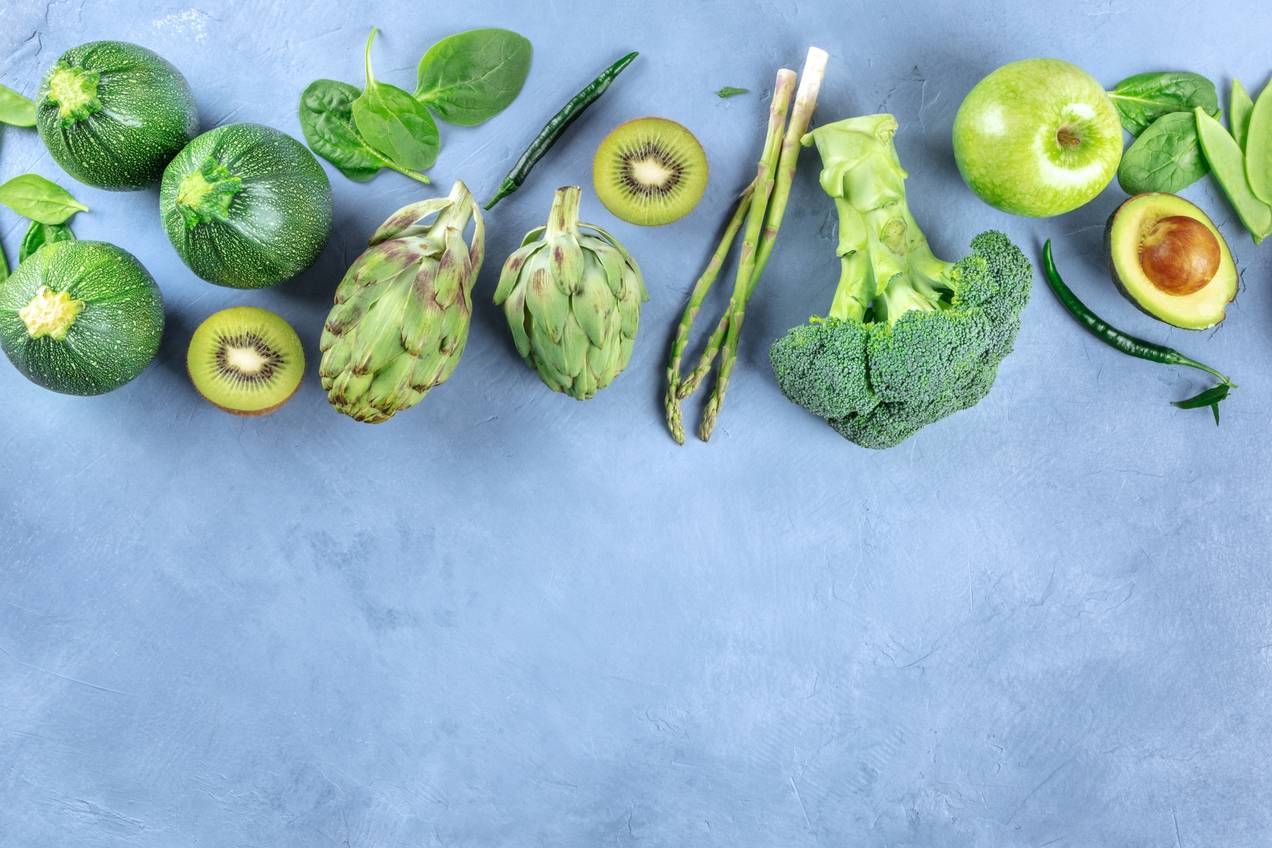
Alkaline foods: table of alkaline foods
Alkaline nutrition is still in vogue. The theory behind this is that the body becomes “acidic” due to too many acid-producing components in daily food. You can counteract this with an alkaline diet.
FIT FOR FUN explains which foods are alkaline, how you can integrate them into your diet and why the sour-tasting lemon is defined as an alkaline food.
What are alkaline foods?
Alkaline foods are the counterparts to acidic foods. They have a high proportion of basic minerals such as potassium, magnesium and calcium and are metabolized in the body in an alkaline manner.
If the acid-base balance is unbalanced, health-damaging symptoms can occur. Proponents of the alkaline diet therefore rely on low-acid and alkaline foods.
Advertisement
The aim of an alkaline diet is to stabilize the acid-base balance, relieve the burden on the regulatory mechanisms and prevent hyperacidification.
Hyperacidity can potentially lead to various diseases or chronic conditions such as:
Some alternative medicine experts attribute almost every illness to hyperacidity. In order to avoid this, so-called alkaline foods are used in the alkaline diet
However, the effect of alkaline nutrition has so far been largely unproven scientifically. Our body also has some highly efficient mechanisms and organs (such as the kidneys or liver) that prevent hyperacidity.
List of alkaline foods: Alkaline fruit
| Alkaline fruit | ||
|---|---|---|
| Apples | pineapple | Apricots |
| Bananas | Pears | Clementines |
| Dates (fresh) | Strawberries | Figs |
| blueberries | Raspberries | Cherries |
| kiwi | Limes | Tangerines |
| Mangoes | Melons | Mirabelle plums |
| Oranges | Grapefruits | Papayas |
| Peaches | Plums | Quinces |
| Gooseberries | Starfruit | Dried fruits |
| grapes | Lemons | plums |
List of alkaline foods: Alkaline vegetables
List of alkaline foods: Alkaline herbs, mushrooms and sprouts
| Basic mushrooms | Alkaline herbs & spices | Basic sprouts & germs |
|---|---|---|
| Chanterelles | nutmeg | Broccoli sprouts |
| Oyster mushrooms | cloves | Boxhorn trefoil |
| Shiitake | Chili peppers | Radish sprouts |
| Mushrooms | oregano | |
| mushroom | dill | |
| Morel | Parsley | |
| truffle | pepper | |
| peppermint | ||
| rosemary | ||
| sage | ||
| chives | ||
| coriander | ||
| thyme | ||
| Ginger | ||
| Vanilla |
List of alkaline foods: Alkaline drinks
| Alkaline drinks |
|---|
| Water |
| unsweetened herbs and fruits |
| Water with lemon juice or apple cider vinegar |
| Vegetable juices without added sugar |
| Fruit smoothies with no added milk or sugar |
The difference between acidic and alkaline foods
Alkaline foods include foods that activate alkaline formation in the body or provide your body with alkaline minerals. They are therefore also referred to as 'base-forming'.
The acid-base representation therefore does not show the acidity of food, but rather a constructed value that refers to the components into which a food is broken down through digestion and metabolism.
For example, lemons are naturally acidic due to their many fruit acids and vitamin C, ascorbic acid. But here it comes: The fruit acids are quickly broken down in the body. After that, alkaline substances predominate, such as the minerals potassium and magnesium.
This means: If more alkaline than acidic products remain after a food has been digested and broken down, this food is classified as alkaline.
Using lemons as an example: They provide the body with the basic minerals magnesium and potassium – hence the final term “alkaline-forming”.
Many vegetables and fruits, herbs, mushrooms, sprouts and sprouts and almonds also fall under the category of alkaline foods.
There are differences in the alkalinity content of different types of fruit and vegetables. Alkaline foods are divided into highly alkaline and medium to weakly alkaline foods.
For example, spinach, carrots, celery, dark leaf lettuce (e.g. rocket), green beans, cauliflower, savoy cabbage, fresh peas, tomatoes, cucumbers, beets, white beans and bananas have a strong alkaline effect.
Most types of fruit, on the other hand, have a weak to medium alkaline effect.
Acidic or acid-forming foods should largely be avoided when following an alkaline diet, as they negatively affect the acid-base balance in the body. This category includes milk and dairy products, fish, meat, eggs, sweets and grains.
Order a book on the topic of “acid-base balance” online
Good acid generators vs. bad acid generators
- Good acidifiers are very nutrient-rich and healthy – but you should enjoy them in moderation and always combine them with alkaline-forming foods.
These include whole grain cereals and products, oats/oat flakes, legumes, whole grain rice, millet, nuts (e.g. hazelnuts, walnuts, macadamia and Brazil nuts), oilseeds (linseed, sesame – but also sunflower and pumpkin seeds, chia and poppy seeds). , pseudograins (amaranth, quinoa and buckwheat) or tofu.
Vegetable oils and high-quality fats are neutral foods: for example olive, linseed, pumpkin seed or hemp oil, organic butter and ghee).
- Under 'bad acid generators' refers to all heavily processed products from the food industry as well as fast food. They should be consistently avoided or only eaten in exceptional cases.
These include: ready-made products and drinks, dairy products, grain products made from white flour (e.g. cakes, pastries, pasta, cereals), products made from gluten (vegetarian bolognese, cold cuts or seitan), heavily processed soy products (minced meat substitutes or soy protein), products containing industrial sugar, alcohol and Coffee and other caffeinated drinks.
Good and bad acid generators at a glance
| Good acidifiers | Bad acid generators |
|---|---|
| Grains: spelled, rye, barley, corn | Grain products made from white flour: baked goods, pasta, cereals |
| Grain products: bulgur, couscous, oat flakes | Meat and meat products: sausage, ham, offal |
| Pseudo-cereals: quinoa, amaranth, buckwheat | Fish and seafood: salmon, shrimp, herring |
| Legumes: lentils, beans, soybeans, chickpeas, peas | Milk and dairy products: yogurt, quark, pudding |
| Tofu and fermented soy products: miso, tempeh | heavily processed products: ready meals, sauces, etc |
| nuts | Eggs |
| Oil seeds: sesame, linseed, pumpkin seeds, poppy seeds, hemp | Alcohol, soft drinks, sodas, caffeine |
| Cocoa and raw cocoa powder | highly hydrogenated fats (margarine, spreadable fats) |
Why do you need alkaline foods?
At least 50 percent of people are said to be “acidic” – that is, their acid-base balance is more acidic than alkaline.
The risk of a mineral deficiency is the result if we eat too few alkaline foods and instead consume too much meat, cheese, coffee, alcohol and fast food.
Sugar and animal proteins are also considered acid-forming. If there is also a lack of exercise, stress and possibly nicotine, health problems are likely.
Eating balanced and healthy seems to be even more important! With lots of fresh foods such as fruit and vegetables, whole grain products, legumes and nuts, you are definitely on the safe side – and you no longer have to worry about your acid-base balance.
Sour isn't always fun: You can find the biggest acid generators in the picture gallery
Alkaline excess diet
A purely alkaline diet with alkaline foods is very strict and difficult to implement in everyday life.
That's why a slightly more relaxed version has been around for some time now: the alkaline-excess diet. This diet mainly uses alkaline foods, but acid-forming foods are also allowed – but not the strong acid-forming ones!
Many of the weakly acid-forming foods contain important minerals and vitamins that enrich our diet and can contribute to a healthy diet.
Many nutritionists recommend 70 to 80 percent alkaline foods and 20 to 30 percent acid-forming foods as a guideline for your own diet.
Cooking with alkaline foods
If you want to get started with an alkaline diet, it's best to put lots of fresh fruit and vegetables on your plate and avoid fast food and processed products.
The ratio of alkaline to acid-forming foods should be 80 to 20 percent. In practice it can look like this:
- Soups based on pumpkin, potatoes or turnips: Cook the vegetables in vegetable broth until soft, puree and season to taste.
- Instead of cream and other dairy products, you can also use pumpkin seed or sesame oil to refine it!
- Fresh herbs are an important part of the alkaline diet and spice up every dish! Feel free to try something new – for example chervil for salads or coriander for Asian dishes.
- If you like it creamy: nut butter is ideal for thickening sauces and also tastes great in salad dressing! However, the puree should not contain any added sugar, as this suppresses the alkaline-forming effect in the body.
- Alkaline nutrition experts recommend eating a lot of alkaline foods one day a week and also drinking a liter of alkaline broth (e.g. a broth made from potatoes, carrots, celeriac and ginger).
- There are also so-called base powder or acid-base powder on the market, which is intended to reduce food-related acid exposure and compensate for excess acid. This dietary supplement is composed of a mixture of mineral salt compounds and sucrose and/or lactose.

Russell age 28 years Studying in world cooking I have a degree in England
Studying in world cooking I have a degree in England

